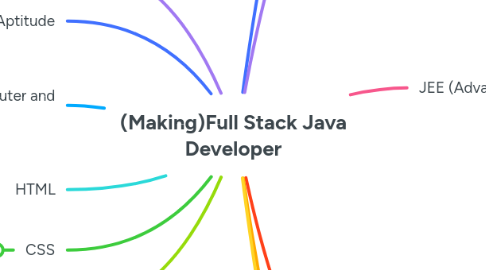
1. SoftSkills
2. Aptitude
3. Fundamentals of Computer and Internet.
3.1. Computer
3.2. Internet
4. HTML
5. CSS
5.1. https://www.codingninjas.com/studio/library/what-are-the-major-difference-between-css-css2-and-css3
6. JavaScript
7. Version Control Systems
7.1. Git (client Tool)
7.2. GitHub (server)
8. Java SE (core java - Main ) programming Language
8.1. Version of JDK
8.2. HelloWorld and Main Method
9. JEE (Advance Java)
9.1. JDBC
9.1.1. What
9.1.2. Why
9.1.3. How
9.1.3.1. javap
9.1.3.1.1. java.sql.Statement
9.1.3.1.2. java.sql.PreparedStatement
9.1.4. Where
9.1.5. Coding
9.1.5.1. FirstCode
9.1.5.1.1. import java.sql.*; class FirstCode { public static void main(String[] args) { Connection connection = null; Statement statement = null; ResultSet resultSet = null; //LOAD AND REGISTER THE DRIVER //we need to load and register the Driver as per the db requirement //=as per the db specification, we need to set the JRE environment with the DB //environment //any class of db vendor, we say it is DriverClass, if it has implemented a interface //called Driver //MySQL connector jar has Driver interface try{ //STEP 1 : load and register the Driver Class.forName("com.mysql.cj.jdbc.Driver");//checked exception System.out.println("Driver loaded successfully..."); //STEP 2 : establish the connection with database //without username and pswd you can't able to access the db // String url = "jdbc:mysql://localhost:3306/nbatch"; String url = "jdbc:mysql:///nbatch"; //FOR LOCAL NEED NOT TO WRITE String username = "root"; String password = "root123"; connection = DriverManager.getConnection(url, username, password); System.out.println("connection established successfully..."); System.out.println("the implement class name is "+connection.getClass().getName()); //STEP 3 : Create Statement object and send the query String selectQuery = "select sid,sname,sage from student"; statement = connection.createStatement(); System.out.println("statement prepared..."); resultSet = statement.executeQuery(selectQuery); System.out.println("result set executed the query..."); //STEP 4 : process the result set System.out.println(); System.out.println("SID\tSNAME\tSAGE"); while(resultSet.next()){ Integer sid = resultSet.getInt(1); String sname = resultSet.getString(2); Integer sage = resultSet.getInt(3); System.out.println(sid+"\t"+sname+"\t"+sage); } }//STEP 5: HANDLE THE SQL EXCEPTION catch(ClassNotFoundException ce) { ce.printStackTrace(); }catch(SQLException sqle){ sqle.printStackTrace(); }catch(Exception e) { e.printStackTrace(); }finally{ if(connection!=null){ try{ connection.close(); System.out.println("connection resources closed successfully..."); }catch(SQLException sqle){ sqle.printStackTrace(); } } } } }
9.1.5.2. JDBC code in simple
9.1.5.2.1. download thirdparty supplied jar respective DB vendor
9.1.5.3. Img and pdf's insertion
9.2. Servlet
9.2.1. require webserver (Apache Tomcat)
9.3. JSP
10. DataBase Lang's
10.1. SQL (Lang for RDBMS)
10.1.1. RDBMS (softwares)
10.1.2. Queries & Concepts
10.2. NoSQL
10.2.1. DBMS (softwares)
10.2.2. Queries & Concepts
11. Documentations
12. DB's softwares
12.1. SQL YOG
12.1.1. https://github.com/webyog/sqlyog-community/wiki/Downloads
